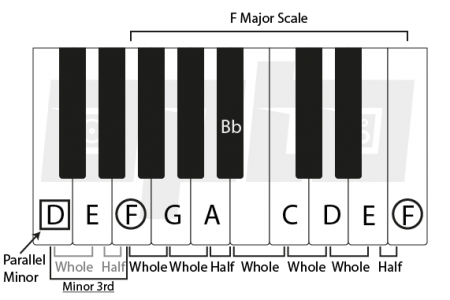In part 3 of this series about music production basics, we’ve introduced the major scale and the names of the black and white keys on a piano. In this part, we are going to learn a new scale, called the Minor scale and we’ll talk about intervals.
Minor Scale
In part 3 we’ve learned that the Major scale is made up of a specific pattern of whole steps and half steps:
W-W-H-W-W-W-H.
W is short for ‘whole’ step and H stands for ‘half’ step.

It is possible to change the starting position of this pattern to create a completely new scale. The Minor scale has the following pattern:
W-H-W-W-H-W-W.
This pattern can be applied across al the 12 keys on a piano.

If we start on A and follow the pattern we’ll get:
A (W) B (H) C (W) D (W) E (H) F (W) G (W) A
The half notes naturally occur between B and C and between E and F. The unique case where two different scales use exactly the same notes is called a parallel key. A Minor is the parallel key of C Major. Even though both scales use exactly the same notes, they still sound different. This is because we don’t just listen to notes, we listen to the space in between notes. This space is called an interval.
Intervals
Since each Diatonic scale has 7 notes, we also have 7 intervals. Every interval has its own unique name: prime (unison), second, third, fourth, fifth, sixth, and seventh. A prime or perfect unison is the interval between exactly the same notes, C to C. If you would move from one C to another C above or below the current C then you would call it an octave because it is the 8th note away from the starting note. The starting note is called the root note. The rest of the notes are pretty self-explanatory. D is the second note of the C major scale and is thus called a second. E is the third note and is called a third etc.

Major and Minor Intervals
Some intervals can have different values however and this has to do with the number of whole steps and half steps. In the C major scale the second note, D, is one whole step away from C. We call this a Major Second. The interval between E and F is however only a half-step which we, therefore, call a Minor Second.

The same can be applied to any third interval. The interval between C and E has 2 whole steps and is thus called a Major Third. If we look at the A minor scale however there is a difference. The interval between A and C is a Minor Third because there is a half-step in between B and C. This third plays a big role in the different sound between the Major and Minor scale.

In the C Major scale, the sixth, from C to A is a Major Sixth because there is only one-half step in between. The sixth in the A minor scale (A to F) is named a Minor Sixth because it has 2 half steps in between.

The same can be said for any seventh. The C major scale has a Major Seventh and the A minor scale has a Minor Seventh.

Perfect Intervals
Two exceptions are the fourth and fifth intervals which are called a Perfect Fourth and a Perfect Fifth in both Major and Minor scales. These are the basic intervals you should know about. There are a couple more, but I won’t bore you with those for now.

One handy trick to find the parallel minor scale of any major scale is to start at the root note and go down a minor third. Let’s say you want to know the parallel minor key of F Major. The root note is F and one minor third down you can find D. So the parallel minor key of F major is D minor. You can check this by apply ing the minor scale pattern:
D (W) E (H) F (W) G (W) A (H) Bb (W) C (W) D

By comparing these notes to the F Major scale we looked at in Part 3 you’ll see that both scales have exactly the same notes.

Context
One last thing I want to say is that music is all about context. If you would play the C major scale on a piano and immediately after it you would play the A minor scale, it could be hard to hear the difference. That’s because your ears need some time to get used to the new scale. A simple way to compare the two is to first play the root note: C a couple of times and then play the C Major scale. Then pause for a few seconds and play the root note: A a few times before you play the A Minor scale.
This idea of context will be important later on when we talk about chords & chord progressions. For now, you’ll know how to figure out the notes of a specific scale and you will be assured that every note you play in this scale will fit together nicely. Now that we’ve got that out of the way we can finally work on creating some beautiful melodies in part 5 of this series about music production for beginners.











